Widescreen Weekend review |
Read more
at in70mm.com The 70mm Newsletter |
| Written by: Ramon Lamarca Marques, 65/70mm Workshop | Date: 11.04.2009 |
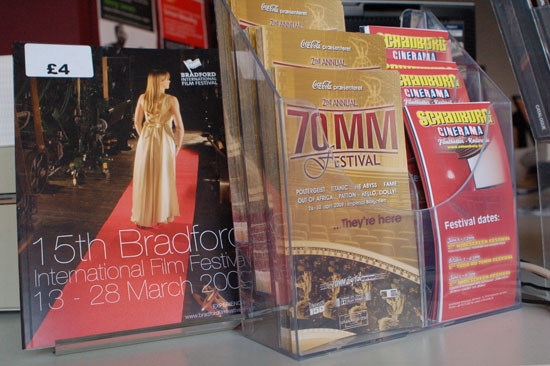 After missing 2007 and seeing only a few films in 2008, I was craving
another full widescreen weekend and this year’s programme was certainly
promising. After missing 2007 and seeing only a few films in 2008, I was craving
another full widescreen weekend and this year’s programme was certainly
promising.One of the best titles of the weekend was paradoxically a title not included in the official WSW schedule, "A Star is Born", a film that Warners had originally planned to produce in 3-D (according to R.M Hayes’s 3-D Movies book). The print did not have the original Cinemascope ratio of 2.55:1, which is preserved in the DVD version, but nevertheless it was a fairly good print. This is the restoration of the film print and, as with the DVD edition, this print includes stills of the film replacing the missing footage, with the original soundtrack, thus reconstructing as faithfully as possible Cukor’s original version. Dave Strohmaier was involved in the search of the missing footage. Needless to say, "A Star is Born" is an excellent film with Cukor’s elegance written all over it. James Mason’s performance is terrific and the musical numbers, albeit a bit forced within the story at some points, are mostly very good. Some set designs in the musical numbers reminded me a bit of those that would be used later for "My Fair Lady". I like very much these early Cinemascope films where directors and photographers were discovering the new medium and making the most of it. This film was clearly framed for 2.55:1 with some of the sides looking cropped in the 2.35:1 version we saw in Bradford. There were no end credits on the print or they were not projected; they are included in the DVD. As a curiosity, Rick Mitchell, Widescreen historian, mentions that the Zeiss lenses were used for the scene in which Judy Garland works as a carhop, but these lenses were deemed of inferior quality to the official Bausch & Lomb lenses. Another CinemaScope film ensued, this one was one of only two CinemaScope 55 films ever made, "The King and I". This print preserved the original aspect ratio by letterboxing. Bill Lawrence asked the audience (prior to "Carousel" screening) to confirm the right width of the negative of the CinemaScope 55 system; there is a very good article on it on the Widescreen Museum, with samples of original negative film. I have read that the new print has lost the original colours due to the bad condition of the negative. I can only compare it with the faded Grandeur 70 print they have in Bradford and so the colours looked fine to me. It was obvious to me the extra sharpness of CinemaScope 55, and it is a pity Fox has not released a letterboxed 70mm print of it to make the most of the larger negative. I find the film too static, like filmed theatre, but nevertheless there are good songs and, obviously, Yul Brynner’s rendition of the King is one of the best aspects of this film. Seeing how static this film is I could not help but think that when filming a musical the camera must dance, something that directors like Gene Kelly, Stanley Donen, Robert Mamoulian or Robert Wise knew. There were no end credits either or, again they were not projected. I would imagine that, at least, a cast end credits should be present, but I am not certain. Talking about dynamic widescreen musicals, I would like to request a showing of "It's Always Fair Weather" in a future edition of the Widescreen Weekend. On Friday I decided to see "This is Cinerama" for the second time. The print is still in very good shape. An enjoyable ride. |
More
in 70mm reading: Widescreen Weekend 2009 • Gallery: 2009 • WSW Home • Through the Years • The Best of WSW • Academy of the WSW • Creating the WSW • Planning the WSW • Projecting the WSW • Home of CINERAMA • Projecting CINERAMA Film Introductions: "The Bible...in the beginning" "How the West Was Won" "Khartoum" "The King and I" "This is New Zealand" "West Side Story" "Faubourg 36" 70mm in Paris "This is New Zealand" 3-strip EXPO Film From New Zealand The M.C.S.-70 Process 65/70mm Workshop Internet link: |
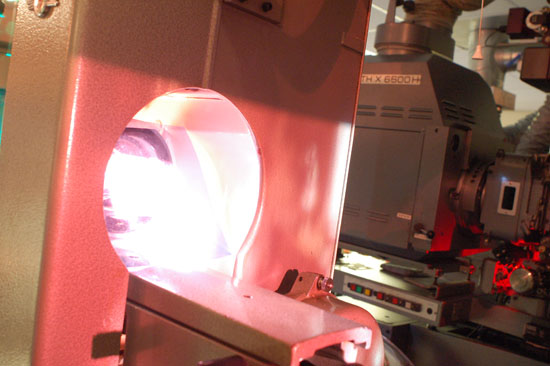 "The Taming of the Shrew"
was unfortunately faded and so filters had to be used for projection, which were on top of
the filters already used in the film to give that “awful” soft focus look
they liked so much in the late 60s/70s. The result, with so much filters: the
print looked like a faded 35mm print. I think this is one of the clear cases
when, if there is a good 35mm scope print, it should be shown instead of a
bad “blow-up”. One might argue that we can enjoy the 6 track magnetic sound, true,
but in this case Nino Rota’s score did not really sound like recorded for a
6 track mix. I am not a fan of the Bard and since I already know the story
very well, there were no surprises in store for me. "The Taming of the Shrew"
was unfortunately faded and so filters had to be used for projection, which were on top of
the filters already used in the film to give that “awful” soft focus look
they liked so much in the late 60s/70s. The result, with so much filters: the
print looked like a faded 35mm print. I think this is one of the clear cases
when, if there is a good 35mm scope print, it should be shown instead of a
bad “blow-up”. One might argue that we can enjoy the 6 track magnetic sound, true,
but in this case Nino Rota’s score did not really sound like recorded for a
6 track mix. I am not a fan of the Bard and since I already know the story
very well, there were no surprises in store for me.After Burton/Taylor’s romp came the jewel of the crown, "Faubourg 36". Maybe it wasn’t the best film of the weekend, but doubtless it was an example of the very good showmanship often exhibited by the Bradford team. Christophe Barratier’s film was a lovely and warm story of human struggle. Yes, many of the plots and subplots present have been done before, but I was gladly surprised about the unlikely hero, Pigoil, a middle-aged, short and bald man. Yes, we have also the handsome young couple to please conventional audiences, but Pigoil is the star. Some members of the audience expressed being moved by "West Side Story" or "Carousel" (it really surprised me seeing British people confessing to being moved publicly, times are changing!). I got moved by "Faubourg 36" and its charm, and the scene when the friends bring Piloil’s son to him was really touching. This blow-up print was gorgeous and it shows what a 70mm print can do these days, even coming from a 35mm negative. It is not only much, much, much, much, much, much, much, much better than 2k digital projection, but it has something that digital projection hasn’t got yet, and that is soul. The film’s look brings warmth and helps any digital effects added to the film to blend nicely with the real settings. The subtitling was done live using a PowerPoint presentation controlled from a laptop in the auditorium. It was a top-notch job and the subtitles were not intrusive, were very clear and it felt as good as if they were pre-printed subtitles; well done Bradford! The Delegates’ reception was nice as always and I had the privilege to enjoy Paul Rayton’s wealth of information, especially with regards to the lost 6 mag track mix for "West Side Story". I wish him luck in his search for this lost soundtrack and hopefully one day he will write about his exciting research. I did not see "Where Eagles Dare" since I had seen it not long ago in London in 70mm at the Empire cinema. I am told that Mr Nesbitt’s interview was very interesting. |
|
Saturday, March 20, 2009 |
|
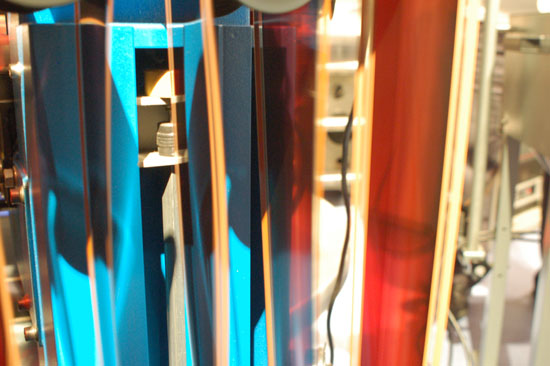 On Saturday, Cinerama Ventures was very amusing and it was great to see the three-strip clip of "Russian
Adventure", hopefully next year we will see
the whole film. The film is faded but it has great resolution, as with all
three-strip films. Randy Gitsch and Dave Strohmaier’s adventures are always
very interesting to hear. I wish them luck in their preservation work on
three-strip titles. On Saturday, Cinerama Ventures was very amusing and it was great to see the three-strip clip of "Russian
Adventure", hopefully next year we will see
the whole film. The film is faded but it has great resolution, as with all
three-strip films. Randy Gitsch and Dave Strohmaier’s adventures are always
very interesting to hear. I wish them luck in their preservation work on
three-strip titles.And then we had the digital European premiere of "How The West Was Won". I do not like 2k video projection but nevertheless decided I had to at least see a bit of this screening to pass some judgement. Yes, the joint lines have disappeared and this is thanks to digital technology, but I had already experienced this on the Blu-ray version of the film I have got at home. As for the rest, well this video print is not designed to be projected on a Cinerama screen and so there was a lot of cropping, also the sides had the distortion inherent to projecting from just one hole instead of three, clearly visible on the main credits with the titles on the side panels going upwards. 2k resolution cannot match the resolution of three 35mm prints running simultaneously. As for the colours, well I rather prefer the dye transfer palette and certainly the blacks are blacker to my eyes in a dye transfer print than a video file like this one. I left after approximately an hour into the film. The sound was not very good in the low register, as compared to the original Cinerama soundtrack and the mix was only 5.1. Alfred Newman’s gorgeous soundtrack did not have the same punch, although there was good tone separation in the mid/high registers. Part of the magic of a Cinerama film is to see it in Cinerama with its flaws. I understand that some people may be curious about new formats and trying new things, but remember that, as the Buggles said, video killed the radio star. “I am a fundamentalist in terms of film heritage presentation but I do have to say that, apart from the flaws mentioned, this electronic print looked nice on the curve”. Then came the most boring story ever told, "The Bible… in the beginning". Certainly, this film had to be shown during the WSW since it is a new print of a Dimension-150 film, but honestly, it was much worse that I envisaged. I had a first attempt at seeing it the first time Bradford showed it on a faded 70mm print, but Morpheus won then and it nearly won this time again had it not been for the nice quality of the print. John Huston is a great director with some flops, and definitely this is one of them. This film’s biggest strength is at converting believers into agnostic or atheist. I mean, one only needs to see Adam and Eve as Caucasian models with 60s hairdo and speaking contemporary English to lose any faith, and this was only the beginning. To me the best moral of the story was that the original sin meant that the soft focus vision of the world disappeared and sharpness appeared on earth, well it remained there until sinners like David Hamilton brought it back in the 70s. There is an interesting point about the film, and that is the score, a mainly atonal, ever-present music that reminded me of what little I have heard from Stravinsky (the composer originally thought for the film, as told by Wolfram Hannemann in his interesting introduction). I managed to sit through the whole film just falling asleep during Noah’s interminable collection of animals (with obvious rear projection for those lions and tigers) and subsequent trip. Babel’s tower meant the momentary defeat of the English language in biblical times, which was soon recovered by Abraham and Co. who kept Shakespeare’s tongue alive (this reminded me of Mel Gibson’s bravura when using original ancient languages for his films "The Passion of the Christ" and "Apocalypto"). Apparently this new print does not have end credits. |
|
 Next was the lecture on digital technology by one of the sponsors of the
festival, although I could not see what the relationship between the lecture
and widescreen cinema was. Certainly, there are new digital cameras and new
digital scope films like "Che
part 1" that could have been used as an
example of new technologies and widescreen cinema, but nothing of this was
mentioned. Instead, we had what looked more like a corporate presentation
(you cannot get away from PowerPoint presentations these days, I am afraid)
of the economics of the implementation of 2K over the world. A bit more
interesting was the 3-D presentation that followed. I have always been
interested in stereoscopic photography and had never seen Dolby’s digital
3-D system. I found the glasses particularly uncomfortable when worn on top
of my own glasses and I found myself repositioning them in the short period
of time of the demonstration. As to the 3-D itself, there was nothing new I
had not seen before. Dual projection, preferable in IMAX 15/70, is still the
best. This digital 3-D was slightly darker than the Real-D screening I had
seen of "Bolt 3-D",
but that is probably due t o the different type of screen at Pictureville
(Darren Briggs mentioned that a screen with more gain would suit Dolby
Digital 3-D system better). As for the demonstration of flat digital, well,
there was a lot of digitally animated material and as usual these days, the
editing was fast and furious so there is little time to assess the image
quality and as it is also usual these days, the soundtrack was loud and
noisy to make the experience even more unpalatable. I think it was after
this when the experimental digital short was shown, with music by members of
Tangerine Dream. It looked nice. By now it must be obvious that I do not
like 2k digital projection. I have grown up with the film look and although
I am certainly open to new artistic ideas and media, this digital 2k project
is mainly a financial thing that adds little to the cinema experience, if
anything at all, and will eventually get rid or projectionists. I am sorry,
but I have little sympathy for what is a money saving exercise. Next was the lecture on digital technology by one of the sponsors of the
festival, although I could not see what the relationship between the lecture
and widescreen cinema was. Certainly, there are new digital cameras and new
digital scope films like "Che
part 1" that could have been used as an
example of new technologies and widescreen cinema, but nothing of this was
mentioned. Instead, we had what looked more like a corporate presentation
(you cannot get away from PowerPoint presentations these days, I am afraid)
of the economics of the implementation of 2K over the world. A bit more
interesting was the 3-D presentation that followed. I have always been
interested in stereoscopic photography and had never seen Dolby’s digital
3-D system. I found the glasses particularly uncomfortable when worn on top
of my own glasses and I found myself repositioning them in the short period
of time of the demonstration. As to the 3-D itself, there was nothing new I
had not seen before. Dual projection, preferable in IMAX 15/70, is still the
best. This digital 3-D was slightly darker than the Real-D screening I had
seen of "Bolt 3-D",
but that is probably due t o the different type of screen at Pictureville
(Darren Briggs mentioned that a screen with more gain would suit Dolby
Digital 3-D system better). As for the demonstration of flat digital, well,
there was a lot of digitally animated material and as usual these days, the
editing was fast and furious so there is little time to assess the image
quality and as it is also usual these days, the soundtrack was loud and
noisy to make the experience even more unpalatable. I think it was after
this when the experimental digital short was shown, with music by members of
Tangerine Dream. It looked nice. By now it must be obvious that I do not
like 2k digital projection. I have grown up with the film look and although
I am certainly open to new artistic ideas and media, this digital 2k project
is mainly a financial thing that adds little to the cinema experience, if
anything at all, and will eventually get rid or projectionists. I am sorry,
but I have little sympathy for what is a money saving exercise. |
|
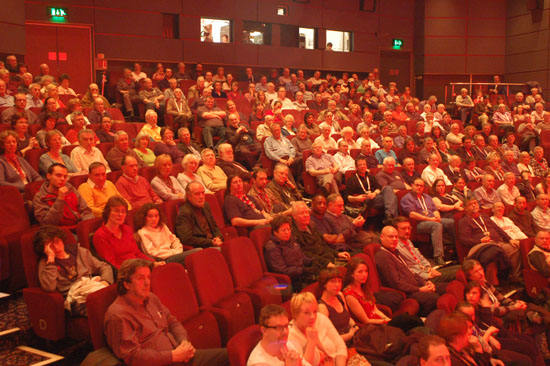 Moreover, video, or digital as it is called these days, may eventually kill
specialised cinemas like the National Media Museum. We travel miles to see
precious prints, either in 35mm, 70mm or Cinerama that cannot be seen
usually anywhere else. It is the rarity of these
classic films, and the idea of recreating the original experience that moves
many of us to spend the money to assist these international festivals. If
these old films are released only in 2k digital cinema, well, then the same
file Bradford will be showing in the future is the one the CineWorld round
the corner will be showing during a weekend matinee. If that happens, who is
going to travel to Bradford? Yes, it is nice to meet the regulars and assist
to the lectures, but honestly I do not think so many delegates would travel
from round the world to assist to digital 2k screenings. Moreover, video, or digital as it is called these days, may eventually kill
specialised cinemas like the National Media Museum. We travel miles to see
precious prints, either in 35mm, 70mm or Cinerama that cannot be seen
usually anywhere else. It is the rarity of these
classic films, and the idea of recreating the original experience that moves
many of us to spend the money to assist these international festivals. If
these old films are released only in 2k digital cinema, well, then the same
file Bradford will be showing in the future is the one the CineWorld round
the corner will be showing during a weekend matinee. If that happens, who is
going to travel to Bradford? Yes, it is nice to meet the regulars and assist
to the lectures, but honestly I do not think so many delegates would travel
from round the world to assist to digital 2k screenings. And then, the magic came back, "West Side Story". I had been wishing to see this film in 70mm for many years. The screening had a failed start without sound but this was rectified and we could enjoy what was a very nice print of a great film. The first musical number is superb and shows what can be done with widescreen cinema. I like Bernstein’s original songs very much and so for me it was a truly enjoyable momentum. The fact that Pictureville was packed added to the experience and reminded me of those times when cinemas were full and people shared the enjoyment of a film like "West Side Story". Ok, Natalie Wood is not Latin, but she is lovely. The original six track mix is lost and we had a 5.1 mix that sounded really good. Paul Rayton is in search of the lost original mix and I wish he finds it soon. Unfortunately, and due to unclear cues for the curtain close we were deprived of Saul Bass’s end credits. There were many Saul Bass’s fans there, amongst whom I count myself, who were disappointed by this. But in all honesty, the projection room goes to a strenuous schedule during the Weekend and do a great job with the presentations. |
|
Sunday, March 21, 2009 |
|
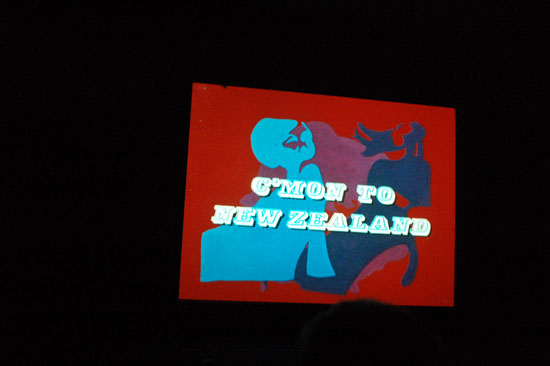 On Sunday we started fairly early with "This is New Zealand", a film which made good use
of the split screen. Before it we had plenty of academy ratio stuff
regarding New Zealand, which showed prospective tourists in the 60s or 70s
that there was enough striptease and booze in New Zealand to make the
holidays worthwhile. On Sunday we started fairly early with "This is New Zealand", a film which made good use
of the split screen. Before it we had plenty of academy ratio stuff
regarding New Zealand, which showed prospective tourists in the 60s or 70s
that there was enough striptease and booze in New Zealand to make the
holidays worthwhile.Cineramacana was disappointing this year, apart from the moving tribute the Bradford team paid to Bill Lawrence. It was too dry and unexciting, but with such an improvised show as Cineramacana, these things can happen. I personally liked the digital screening with a song by No-Man. "Becket" was a very enjoyable film with superb acting by O’Toole and Burton. It was great that they made the effort to bring this print from overseas but it was in very bad shape, faded and with scratches and Czechoslovakian subtitles. Also, from the main credits it was clear that this film was composed for scope 35mm and not 70mm. The only point of the 70mm print was to hear Laurence Rosenthal’s great score, but since there is a fairly new 35mm colour print with Dolby Digital sound from the restoration by the Academy of Motion Pictures Arts & Sciences, I think we should have seen that print instead. |
|
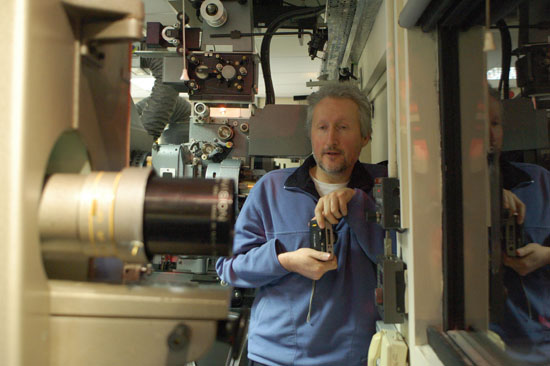 "Carousel"
was the second CinemaScope 55 film of the weekend and
the second and last CinemaScope 55 film ever made.
Although it contains some good tunes and musical
numbers, it seems obvious to me why the film was not a success. Apparently,
Hollywood changed quite a lot of R & H’s original play and some musical
numbers were lost on the way. As it stands in the film, the story makes
little sense and when mother and daughter reminisce about her husband/dad
hitting them and feeling like it was a kiss, I could not help it but being
completely detached from the whole thing, even disgusted at the glossing
over of domestic violence. Nevertheless, the musical number 'June Is Bustin'
Out All Over' is wonderful and it is a pity the rest of the film was not
shot on location. The print was very nice and respected the original ratio
letterboxed. "Carousel"
was the second CinemaScope 55 film of the weekend and
the second and last CinemaScope 55 film ever made.
Although it contains some good tunes and musical
numbers, it seems obvious to me why the film was not a success. Apparently,
Hollywood changed quite a lot of R & H’s original play and some musical
numbers were lost on the way. As it stands in the film, the story makes
little sense and when mother and daughter reminisce about her husband/dad
hitting them and feeling like it was a kiss, I could not help it but being
completely detached from the whole thing, even disgusted at the glossing
over of domestic violence. Nevertheless, the musical number 'June Is Bustin'
Out All Over' is wonderful and it is a pity the rest of the film was not
shot on location. The print was very nice and respected the original ratio
letterboxed."Khartoum" closed the Widescreen Weekend for me. A very enjoyable film, apart from seeing Laurence Olivier drenched in make-up and doing silly accents (it is a pity in those times they were so careless with non-English characters). The print had the proper Ultra Panavision 70 ratio and hence it was not using the full height of the screen. The print was new and in mint condition. I think there were no end-credits screened here either. |
|
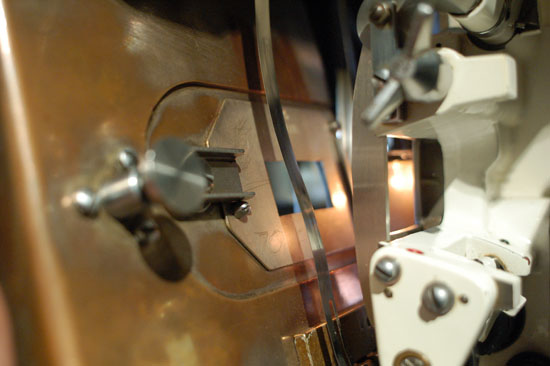 I did not see the films on Monday, but overall it was a very good and
intense weekend for me. Well done Bradford once again. As a curiosity, I
think I heard the words “etcetera, etcetera, etcetera” four times during the
weekend, three on films (“The King and I" and two other films) and
one live (Thomas during Cineramacana). I did not see the films on Monday, but overall it was a very good and
intense weekend for me. Well done Bradford once again. As a curiosity, I
think I heard the words “etcetera, etcetera, etcetera” four times during the
weekend, three on films (“The King and I" and two other films) and
one live (Thomas during Cineramacana).If I could make some petitions for the future would be to keep the showmanship at its best, I would wait a bit until closing the curtains for those of us who like to read who the carpenter was in the film, and keep the curtains closed until the film starts. The logo of the festival projected before the screen and shortly after the film finishes spoils somewhat the experience. |
|
|
Go: back
- top - back issues
- news index Updated 22-01-25 |
|
